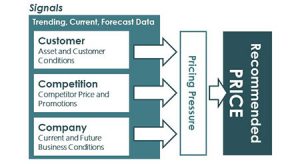
Deriving A Price Through Signals
Big Data is not always available, or practical.
Many industries, where pricing and other data is abundant, use big data analytics to help model an “optimal” price. They can use big data analytics to examine large, complex, and varied data sets. Then, use the analysis to reveal pricing drivers, concealed patterns and correlations.
But many companies and smaller businesses do not have the big data, or the resources, for such analysis. We use Self Storage companies here as an example. Demand at the unit group level is relatively sparse, and therefore pricing data at that level is sparse.
We do have enough data to forecast demand as well as move-outs. However, we have found that the inherent variability of such forecasts is sufficiently great to warrant supplementing these detailed forecasts with other critical and informative pieces of information.
For Self Storage companies, we have devised a set of pricing “signals”, developed over years of experience, that help determine a more profitable price.
The signals fall broadly into three categories. The first category reflects specific conditions associated with your assets and customers. The second category are market signals, such as those based on competitor prices and promotions. The third category would be factors specific to your current and future business condition.

Examples include effectiveness of your current price, the amount of inventory available, and forecasts of demand and turnover (e.g. move-outs), how a customer’s rent relates to the current web rate, how long a customer has been renting their unit, and potentially many other factors.
A mechanism of inputs that you use time and again to derive a price.
If the signals are intuitive and easily understood, then they are more likely to be used. This becomes especially important in the face of staff turnover.
For recommending the best starting rate for new customers, combining these signals into an overall measure of “Demand” or “Price Pressure” helps guide you to a price for your product. Over time, you will find that you will be making responsive pricing changes to reflect your market’s and business’ changing conditions. Changing conditions include an expanding or slowing economy. The key is being responsive and disciplined. You are then on the road to maximized revenues.
In self-storage, where customers are on month-to-month leases, similar arguments can be made for developing insights on the appropriate amount by which to increase the rent of a specific customer.
